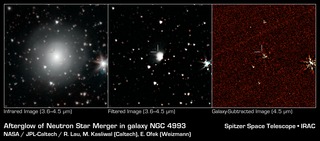
Credit: NASA/JPL-Caltech
Observation • October 16th, 2017 • ssc2017-14a2
ssc2017-14a2
NASAs Spitzer Space Telescope has provisionally detected the faint afterglow of the explosive merger of two neutron stars in the galaxy NGC 4993. The event, labeled GW170817, was initially detected nearly simultaneously in gravitational waves and gamma rays, but subsequent observations by many dozens of telescopes have monitored its afterglow across the entire spectrum of light. Spitzers observation on September 29th comes late in the game, just over 6 weeks after the event was first seen, but if this weak detection is verified, it will play an important role in helping astronomers understand how many of the heaviest elements in the periodic table are created in explosive neutron star mergers.
This image shows the residual 4.5 micron data from Spitzer's IRAC instrument after subtracting out the light of the galaxy using an archival image that predates the event. The faint dot framed by the markers may be one of the last detections made in infrared light of this event.
About the Object
- Name
- NGC 4993
- Type
- Galaxy > Type > Lenticular
- Distance
- 130,000,000 Light Years
- Redshift
- 0.009727
Color Mapping
| Band | Wavelength | Telescope |
| Infrared | 4.5 µm | Spitzer IRAC |
Astrometrics
- Position ()
- RA =13h 9m 48.0s
- Dec = -23° 22' 58.4"
- Field of View
- 3.1 x 3.1 arcminutes
- Orientation
- North is up






